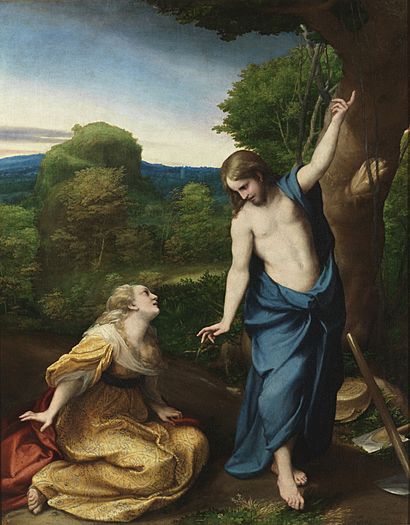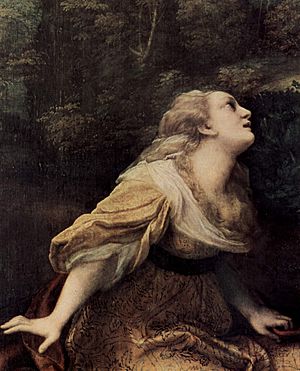Noli me tangere (Correggio) facts for kids
Quick facts for kids Noli me tangere |
|
|---|---|
| Do not touch me | |
 |
|
| Year | c.1525 |
| Dimensions | 130 cm (51 in) × 103 cm (41 in) |
The painting Noli me tangere (pronounced NOH-lee meh TANG-eh-reh) means "Do not touch me" in Latin. It's also called Christ Appearing to Mary Magdalene in the Garden. This famous painting was made around 1525 by an artist named Correggio. It shows a special moment between Jesus and Mary Magdalene right after Jesus came back to life, which is called the Resurrection. You can see this painting today at the Museo del Prado in Madrid, Spain.
Contents
Journey of the Painting
This painting was first mentioned around 1560. It was owned by the Ercolani family in Bologna, Italy. A famous writer named Vasari praised it in his book about artists in 1568.
Later, in the late 1500s, a cardinal named Pietro Aldobrandini bought it for a very high price. It then moved to the collection of Ludovico Ludovisi.
About ten years later, Prince Niccolò Ludovisi decided to give some of his best artworks to Philip IV of Spain. The Noli me tangere painting was one of these gifts. It left Rome in the late 1630s or early 1640s. After a short stop in Naples, it arrived in Madrid by 1643. It has been in the Prado Museum ever since.
The Story Behind the Painting
The scene in the painting comes from the Gospel of John in the Bible. It tells what happened on the first Easter morning.
Mary Magdalene at the Tomb
It was Sunday, three days after Jesus was crucified. Early in the morning, while it was still dark, Mary Magdalene went to the tomb where Jesus' body had been placed. She was very sad.
When she arrived, she was surprised to find that the large stone covering the tomb's entrance had been moved. Confused, she ran to tell two of Jesus' disciples, Peter and John.
Discovering the Empty Tomb
Peter and John hurried back with Mary to the garden. They went inside the tomb and found it empty. They couldn't understand what had happened, so they went home.
Mary stayed behind, standing outside the tomb and weeping. As she cried, she looked into the tomb again. She saw two angels dressed in white. They asked her why she was crying. Mary told them it was because Jesus' body was gone, and she didn't know where it was.
Meeting Jesus in the Garden
After talking to the angels, Mary turned around. She saw a man standing there but didn't realize it was Jesus. She thought he was the gardener.
Jesus asked her, "Woman, why are you weeping? Who are you looking for?" Mary replied, "Sir, if you have taken him away, tell me where you have put him, and I will go get him."
Then Jesus simply said her name: "Mary." When she heard her name, she instantly recognized him. She cried out, "Rabboni!" which means "Teacher."
"Do Not Touch Me"
Mary was so happy and surprised that she probably wanted to hug him. But Jesus told her, "Do not touch me, for I have not yet gone up to my Father."
He then gave her a message: "Go to my brothers and tell them, 'I am going up to my Father and your Father, to my God and your God.'" This is the moment the painting shows.
What the Painting Shows
The painting captures the exact moment Jesus speaks to Mary. She has just recognized him. She is kneeling, and it looks like she was about to reach out to him. But Jesus stops her with a gesture.
Mary looks up at him with great wonder and devotion. Jesus is explaining the important message she needs to share with his followers.
Jesus' Appearance
Jesus is wearing a simple, heavy cloak tied at his waist. The top part of the cloak is slipping, showing his bare upper body. His body looks very strong and graceful, like a Greek statue.
On the ground next to him, you can see some garden tools, like a hoe and a spade, and a straw hat. These items help explain why Mary first thought he was the gardener.
Jesus' pose shows what he is saying. He leans slightly away from Mary, as if to emphasize "Do not touch me." He holds out his right hand, repeating that message. Then he raises his left arm, pointing towards heaven. This shows he is about to go to his Father. He seems to be speaking gently, looking down at Mary with a kind smile.
Mary Magdalene's Appearance
Mary Magdalene is dressed in a beautiful brocade gown. Her neck and arms are visible. Her long, wavy golden hair falls over her shoulders.
Her hands look delicate, suggesting she comes from a good family. Her face might not be considered perfectly beautiful, but her expression is full of deep devotion. She looks completely focused on Jesus, forgetting everything else around her.
The way Jesus is painted, with his smooth forehead and gentle smile, is similar to how Correggio painted Christ in another famous work called Ecce Homo.
See also
 In Spanish: Noli me tangere (Correggio) para niños
In Spanish: Noli me tangere (Correggio) para niños


